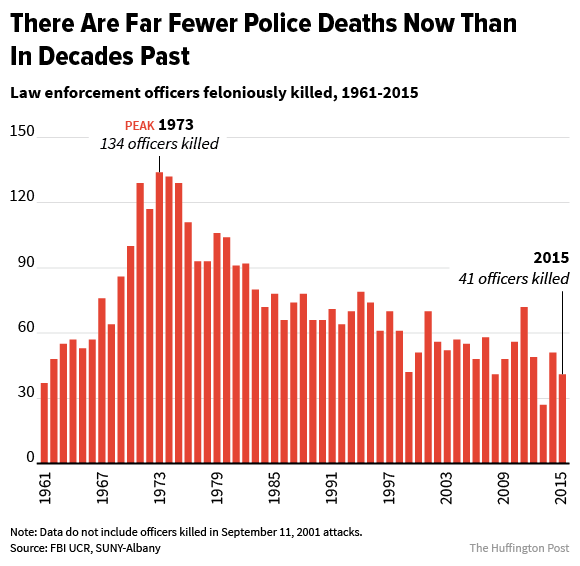After a presidential campaign in which Donald Trump and his surrogates regularly claimed law enforcement was under assault from an increasingly lawless public, the first year of Trump’s presidency is shaping up to be among the safest ever for police.
A total of 45 officers have been feloniously killed in the line of duty in 2017, according to unofficial FBI data updated earlier this month. That number tracks closely to other counts from independent sites and marks a significant downturn from 2016, when a total of 66 officers were feloniously killed. Barring a catastrophe in the final days of the year, the annual total will be well below the average seen over the last 20 years.
These figures follow a year in which Trump and other administration officials have sought to build on the president’s self-described “law and order” campaign by speaking out against a perceived uptick in attacks on police and pushing back against police reform efforts.
One of Trump’s first official acts as president was to sign an executive order “Preventing Violence Against Federal, State, Tribal, and Local Law Enforcement Officers,” a largely symbolic gesture that dovetailed with his campaign rhetoric.
At a ceremony for fallen officers in May, Trump cited violence against police in 2016 as evidence of an emerging crisis for law enforcement.
“We are living through an era in which our police have been subject to unfair defamation and vilification, and even worse … hostility and violence,” Trump said. “More officers were slain last year in ambushes than in any year in more than two decades.”
Although more officers were killed in 2016 than in the preceding few years, that total was largely driven by two high-profile ambush incidents in Texas, in which five officers were killed, and Louisiana, in which three were killed. Four officers were killed in ambush attacks in 2017, according to the FBI.
While the 2016 increase in police killings was a cause for concern, it came after years of record-low numbers in 2013 and 2015. A closer look at historical counts also shows that although the 2016 total was above average for recent years, it was less than half of the peak total in 1973, when 134 officers were feloniously killed.

Despite the lack of clear data, Attorney General Jeff Sessions has eagerly pushed the narrative of a mounting assault on police. In August, he held up the officers killed in 2016 as evidence of “rising levels of violence against law enforcement.” He attributed this in part to critics of police brutality, whom he accused of slandering “all of the honorable men and women” of the profession.
“Last year, 66 law enforcement officers made the ultimate sacrifice in the line of duty – a 61 percent increase compared to 2015,” said Sessions. “And FBI data shows that about a third of those deaths were the result of premeditated or unprovoked attacks. This deadly trend seems to be getting worse. Preliminary data shows that officer deaths for the first six months of 2017 are up 18 percent.”
It’s unclear which figure Sessions was prematurely referring to, but the year-end data shows that felonious killings of police officers declined in 2017. Still, Sessions has moved quickly to roll back Obama-era police reform efforts, in part over his concerns that they’ve helped foster an environment of hostility toward law enforcement.
Public officials and law enforcement groups have routinely politicized data on police killings over the past few years, using it as fuel in a contentious debate over police brutality and accountability. By doing so, they often take numbers out of context, said Philip Stinson, a criminologist at Ohio’s Bowling Green State University.
“When you look at crime trends, you have to look at many data points over many years,” said Stinson. “When you look at things over the short term, I have trouble making sense of it in terms of: Does it mean anything? Is it statistically significant? Is it just that we’re paying more attention? Are they really on the rise?”
Policing is a violent profession, and deaths tend to fluctuate up and down. Efforts to tie certain events or data points to broader social trends can often produce misleading conclusions, said Stinson.
“I never did think it was open season on policing,” he said. “I think it’s business as usual.”
But killings of police alone might not tell the whole story of violence against law enforcement, said Chuck Canterbury, president of the Fraternal Order of Police (FOP), which bills itself as the largest police union in the world.
“We don’t think it’s down at all,” he said. “We’ve had the same amount of shootings that we’ve had last year, and we’re the only people tracking that.”
The total number of officers shot in 2017, both fatally and non-fatally, is consistent with the previous year, Canterbury claimed. He declined to release FOP’s data to HuffPost.
And while there’s an ever-present fear among officers about violence, not all attacks on police are physical, said Canterbury. Police departments in many jurisdictions are also struggling with issues of pay and benefits, officer retention and staffing, which he hopes policymakers will be willing to address in the coming years.
“What we can’t have is a two-pronged attack, when the politicians are attacking our pay and benefits and the criminals are attacking our lives,” he said. “You get to a point where you say, ‘Is this worth it anymore? They obviously don’t care about me as an officer, I’m not gonna go out there and put my life on the line anymore if they keep treating me this way.’”
